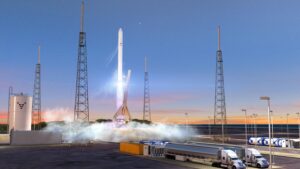Relativity Space raises $500 million
By Jeff Foust

WASHINGTON — Small launch vehicle startup Relativity Space has raised a $500 million funding round that the company says will enable it to accelerate its long-term vision of reshaping aerospace manufacturing.
Relativity announced Nov. 23 that it raised the $500 million Series D round, led by hedge fund Tiger Global Management. Several new investors joined the round, including Fidelity, Baillie Gifford, ICONIQ Capital, General Catalyst, XN, Senator Investment Group, and Elad Gil. The company’s existing investors also participated in the round, which valued the company at more than $2 billion.
The funding round is among the largest for a space company, rivaled only by investments in OneWeb and SpaceX. Tim Ellis, co-founder and chief executive of Relativity, said in an interview that the round was the largest Series D round he was aware of for any company based in the Los Angeles area, regardless of industry.
Relativity raised a $140 million Series C round a little more than a year ago, funding that was intended to take the company through the first launch of its Terran 1 rocket next year. “We weren’t looking to raise right at this exact moment,” Ellis said of the new round. The majority of the funding from that Series C round remains available, he said.
The new round, he said, “lets us think more long term, and really accelerate some of these long-term initiatives that we’ve been planning for some time.” That includes building up its production capabilities, launch vehicle development and 3D-printing technologies, although Ellis said specific details about its plans won’t come until next year.
“It really is about accelerating the long-term vision and plans of the company,” he said. “We’re not short of ambition.”
Relativity’s near-term focus is on the Terran 1, the launch vehicle it has been developing using additive manufacturing technologies. The company recently completed a full “mission duty cycle” static-fire test of the rocket’s Aeon 1 engine, running it on a test stand for 186 seconds. Work has also started on the company’s first launch site at Launch Complex 16 at Cape Canaveral Air Force Station, a schedule that supports a first launch in late 2021.
The new investors, Ellis said, appear confident in the company’s plans, noting that they did not take any new seats on the company’s board of directors. “It really lets us keep our heads down and is a big sign of trust by this investor group,” he said.
Terran 1 will be able to place up to 900 kilograms to a sun-synchronous orbit and 1,250 kilograms into lower inclination orbits. That capacity, as well as its payload fairing three meters in diameter, sets the vehicle apart from competitors in the small launch market, he argued. “The increase in payload volume means we’re able to launch satellites that are quite a bit larger, physically, than other launch vehicles even if they could fit by mass,” he said. “The funding round is a massive validation of the customer traction that we have garnered to date.”
The new round could go beyond simply scaling up production of the Terran 1. The large size of the round has led some in the industry to speculate that the company could use it to leverage its 3D-printing technology for applications beyond its launch vehicle.
Ellis said the company’s ultimate goal is to use its manufacturing technologies on Mars to support human settlements there. That requires the development of flexible, lightweight systems that can operate with a minimum of human labor, capabilities he said could also have applications on Earth. “All of those same parameters also happen to build a really lucrative business on Earth and a new, disruptive value chain for aerospace.”
“The factory we’re building, by its very nature, is driven by software and can be reconfigured for all sorts of things,” he said. “We already know that, on Mars, we have to develop a factory that can build many things, so I do see that as something that could be in the path for a later date.”
But, he added, “We’re very focused right now on Terran 1 and just getting to launch and orbit to serve the customers we’ve signed.”
November 24, 2020 at 04:16AM
via SpaceNews read more...

Post a Comment